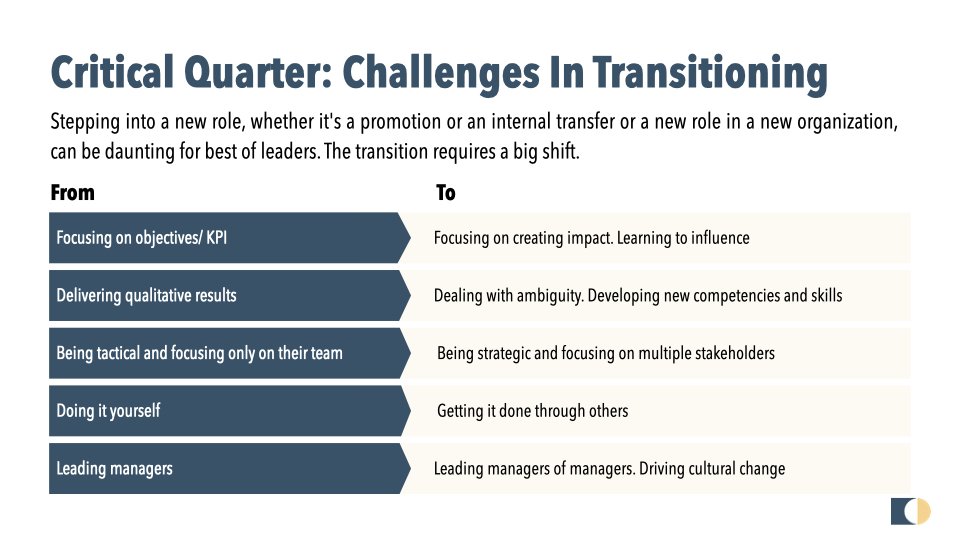Is transitioning into your new role giving you nightmares?
Throughout our careers, we experience changes in environment and responsibilities; leadership transitions and changes in the workplace are more common than ever. We may be asked to work at a higher level of leadership or in an entirely new area. These changes don’t always go to plan, which can result from poor planning or lack of support.[1]
Successful leadership involves navigating a diverse set of challenges, processes, and relationships. Stepping into a new leadership position, either as an internal or external hire, is even more challenging. It is important to look at the common challenges new leaders may experience and create strategies that will help mitigate them.
The common challenges faced by leaders while transitioning into a new role can be grouped under three categories: skills, stakeholders, and mindset. This article will focus on these three broad categories and discuss the traps that many new leaders fall into, along with strategies that new and transitioning leaders can implement to make their mark in their new roles.
Skills and Domain
With every new role—particularly when an employee has been promoted—there is a gap between the individual’s existing skills and strengths and those required for the new role. Whether the employee has overestimated their abilities or the scope of the new position is broader than they have experienced, the transition will be demanding.
If you’ve accepted a new leadership role, you must understand and become familiar with the expectations of the role—the ways you will need to grow to fill it—so that you can ask for the support you need. This support might involve executive coaching, finding a peer mentor, or changing your team to balance areas that need development.[1]
There is always a leap involved when someone transitions into a leadership role, with 83% of global leaders citing that they felt unprepared for their new roles.[2] New leaders need to feel supported; however, only 32% of global leaders think their organisations offer them the appropriate support.[3] Many organisations approach new leaders with a hands-off approach and rely on these new employees to self-manage. However, most new leaders experience only a small number of leadership transitions in their working life, and there is no one formula for success.[4]
If you want to have a successful transition into your new leadership role, it is essential that you first accept that there will be challenges—and that’s okay! Prepare for a gap between your experience and the requirements of the new role, and be sure to line up a peer mentor or coach. Remember that it is acceptable to ask for appropriate help and support from your team while familiarising yourself with your new role and its relevant responsibilities.
Stakeholders: (Your team)
Every leadership transition creates uncertainty; they are typically high-stakes, high-tension events. When asked to order life’s challenges depending on difficulty, many individuals rank ‘making a transition at work’ more difficult than grief, divorce, or health issues.[5]
Finding your feet in a new environment and building trust with a new team takes time. It involves vision and continuous initiative, as well as an understanding of the goals and expectations of your new team. As a leader, you will also be expected to have an impact-driven strategy, but do not feel that this should be immediate. Your strategy will depend on your team—their skills, communication styles, and motivations—and you should take time to gather information before devising a strategy to present to stakeholders.
Many leadership transitions fail, with leaders citing workplace politics as their main challenge.[6]Unfortunately, this is true for internal and external hires alike, with 69% of internal and 79% of external hires reporting that implementing changes in workplace culture is difficult.[7]
Again, successful leadership transitions take time. Workplaces can help their newly appointed leaders by supplying them with a mentor, a ‘buddy’, or a tailored executive coach, who can then work with you to develop an assimilation plan. This has been shown to double the leader’s likelihood for success in their new role.[8]
To be successful in your new role, you must accept that you are transitioning into a new team, as well as a new role. Get to know your team by asking questions, setting up development meetings, and offering them support where needed. Your team needs to transition under a new leader, too, so make sure you set the tone and create a supportive and open relationship and culture from the outset!
Mindset
Just as there are team-based challenges, you will also experience numerous personal challenges when you step into a new leadership role. Many new leaders experience imposter syndrome, which affects people in all stages of their lives and careers. Manfred Kets de Vries argues that the problem is particularly prevalent in C-suite, managerial, or leadership positions. He states, ‘Often, a leader’s feelings of self-doubt and anxiety are less pressing when they are lower on the totem pole […], but once a leader becomes the CEO, everything they do is highly visible. They are expected to stand on their own.’[9]
To combat imposter syndrome, leaders can actively look for ways to revamp their workplace’s organisational culture. This process will depend on the workplace but may include: expressing your vulnerabilities as a leader by opening communication channels and inviting transparency; encouraging problem-solving in your work and your team; and finally, encouraging your team to get comfortable with asking questions, as this will challenge the idea that we must know-it-all, and will help to combat perfectionism.
Story of a Leader
Transitioning into a new role at work can be incredibly overwhelming, and it can be difficult to know what to focus on or how to prioritise. Many new leaders find themselves getting sucked into strictly operational and transactional issues, and as such, they spend less time building relationships with their new colleagues. This lack of communication can cause problems in the workplace.
Take Amit, for example. Amit mainly had worked with small teams, and in his latest position, he worked in a primarily strategic role. This was until the company he worked for went through a major restructuring, which involved consolidating a few functions and roles within the company. Although the company worked hard to minimise redundancies, quite a few leaders were impacted by the changes. Amit was one of these people.
Due to the restructuring, Amit’s role was absorbed into another, and Amit was made site leader. This meant he was now responsible for the functions and people onsite—there were 2000 people! Amit hadn’t worked in this kind of role before, and he was understandably intimated, so he spoke to his supervisor and was assured of his full support and confidence in him. Amit also spoke to his mentor and some of his colleagues, who were also supportive.
What was most intimidating for Amit was not the work itself but that some of these current peers would become his direct reports in his new role. He wasn’t sure how his peers would react to this new structure and him being their new boss.
Amit had sixty days to prepare for the new workplace structure, so he worked methodically to devise a plan and focused on scheduling meetings with his direct reports.
When the new structure was implemented, Amit felt ready. He was able to take an objective and analytical look at each department’s performance, and he shared his opinions with his team at a meeting. Amit thought he appeared objective when pointing out gaps in the team’s overall performance, but his peers did not see it like that, and they were not happy. Communication problems started to fester, but they weren’t addressed quickly enough. The next three to four months flew by, and the communication gap continued to grow.
Amit was working longer hours than usual, but his interactions with his peers became even less—some even began to avoid him. Amit continuously checked in with his manager and was assured that he was doing fine.
Despite this, when the annual employee engagement survey was rolled out, Amit was shocked to find that his direct reports rated him poorly! Amit was confused, so he took some time to reflect and speak to his mentor.
After this, he realised he had been using his old skill set to succeed in a new and different environment and role. What worked for his role as a strategy leader didn’t work for him as an operations leader, and he needed to change that. Amit needed to modify his operating style, so he opened up communication with his direct reports and asked them if they would be willing to help him understand them personally and professionally. He made changes in his approach from there, and became more inclusive, and took more of an interest in his team on a personal level rather than a strategic one.
Amit also realised—with help from his mentor—that he needed to ask his team for more support.
As a leader, you cannot rely on one core skill set—you need to be multifaceted by building different leadership skills and styles. This is, of course, a process; it takes time. But you can’t be a one-trick pony if you want to be a successful leader.
Harness the power of open communication. If Amit’s story shows us anything, you may have the right intentions, but if your colleagues can’t see that you care about their day-to-day, you are not communicating enough. Check in with those around you, and everyone will reap the benefits.
Finally, building a support system is so important when you are transitioning into a new leadership role. Having a team of supportive peers, mentors, and advisors will help make your leadership transition as smooth as possible. Having a network that will allow you to bounce ideas around or ask for advice is invaluable, as is having the humility to ask for help.
Photo by Lindsay Henwood on Unsplash
In my next article, I’ll delve further into each of the common leadership transition traps and will offer solutions for how you can tackle each of the issues that may come your way as you move into a new leadership role.
Connect with me if you want to know more about - Critical Quarter: Blueprint To Successfully Transition Into Your New Role
[1] Frangos, Cassandra (2018, July 2) 3 Transitions Even the Best Leaders Struggle With. Harvard Business Review.https://hbr.org/2018/07/3-transitions-even-the-best-leaders-struggle-with
[2]Matt Paese and Richard S. Wellins (2015, April) Leaders in transition: Stepping up, not off, Development Dimensions International, ddiworld.com; and “Ascending to the C-suite,”
[3]Executive Transitions Rise (2013, June) Challenges Continue, IED and Alexcel Research.
[4]CEB (2012) High-Impact Leadership Transitions, cebglobal.com.
[5]Matt Paese and Richard S. Wellins, Leaders in transition: Stepping up, not off, Development Dimensions International, ddiworld.com.
[6] Keller, Scott (2018, May, 23) Successfully transitioning to new leadership roles. McKinsey & Company. https://www.mckinsey.com/business-functions/organization/our-insights/successfully-transitioning-to-new-leadership-roles
[7] Ibid
[8]Wheeler, Patricia (2015, April. Executive transitions market study summary report: 2008, The Institute of Executive Development, 2008; “Ascending to the C-suite,”
[9] Friedman, Alexandra (2020, September 3) Overcoming Imposter Syndrome as an Emerging Leader. Forbes.https://www.forbes.com/sites/forbescoachescouncil/2020/09/03/overcoming-impostor-syndrome-as-an-emerging-leader/?sh=35a3c0683697
[1] Keller, Scott (2018, May, 23) Successfully transitioning to new leadership roles. McKinsey & Company. https://www.mckinsey.com/business-functions/organization/our-insights/successfully-transitioning-to-new-leadership-roles






